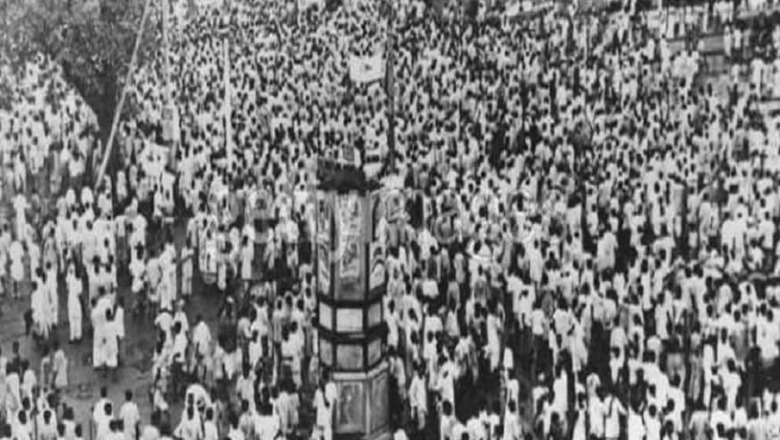
views
Following the carnage at Chauri Chaura on 4 February 1922, Mahatma Gandhi abruptly called off the Non-cooperation Movement. However, the Non-cooperation Movement was a mere appendage, indeed a fig-leaf for the Khilafat Movement. As the objectives of the Khilafat Movement had not been met, it continued without the pretensions of the Non-cooperation Movement. To recapitulate, the original objectives of the Khilafat Movement were four-fold - complete freedom of the Turkish Empire, restitution of Thrace region in south-east Europe to Turkey, restitution of Smyrna (modern-day Izmir) and the coast of Asia Minor (modern-day Anatolia or Asian Turkey) to Turkey and freedom and safeguard of the Jazirat-ul-Arab (Arabian peninsula that includes Islam’s Holy Places).
End of the Khilafat
According to the Lausanne Treaty (24 July 1925) between the Allies and Turkey, Turkey retained Constantinople and Thrace upto the Meritza line with the control of the Straits. Though Turkey had lost her vast empire, yet by this Treaty she managed to emerge once more as the chief power in the Near East. Thus the Treaty met the first three objectives. However, from the Islamic point of view, the fourth objective was most important. The Khilafatists resolved to continue the Movement and even supported Mustafa Kemal initially as they did not reckon that he would abolish the Khilafat.
To the newly formed Turkish Republic, the Khilafat had come to mean an ‘anomalous and anachronistic institution’, which Mustafa Kemal regarded as a constant nuisance and a perpetual danger to the Turkish republic. Turkey, he argued, was no longer in a position either to afford military adventure or to claim the power to defend the rest of Islam.
On 3 March 1924, the office of the Khilafat was abolished and the Khalifa was deposed. The Turkish Nationalists did everything in their power to humiliate and belittle the Caliph. Within hours, the Imperial family was asked to leave Turkey. The passport issued to the deposed Khalifa referred to him simply as ‘Monsieur Abdul-Mejid file d' Abdul Aziz’ and the Italian Embassy was informed that it was not a case for a diplomatic visa.
The Turkish Nationalists also took special measures to ensure the omission of his name from the Friday khutba and substituted it with a prayer for the Republic. The dejected ex-Khalifa had to spend the rest of his life on a stipend from the Nizam of Hyderabad, donations from Indian Princes and magnates and funds from the Red Crescent Society (The Khilafat Movement in India, 1919-1924, Muhammad Naeem Qureshi, dissertation submitted to University of London, 1973, pp.269-271, 276).
Demise of the Khilafat Movement
The shell-shocked Khilafatists continued with their bravado. Maulana Azad even proposed that Mustafa Kemal declare himself as Khalifa. When the Khilafatists woke up to reality, their internal contradictions came to the fore. One bone of contention was Non-cooperation, specifically entry into Legislative Councils. Men like Maulana Abdul Bari and Ajmal Khan favoured entry into the Councils in contravention of official CKC policy and a fatwa issued by Jamiyat-ul-Ulama. A section of the Khilafatists felt that they were subordinating their programme to the Congress. To the Khilafatists, anti-British sentiment was incidental, depending on events affecting Turkey. Certain Khilafatists like Maulana Abdul Bari and Kidwai were in favour of a patch-up with the British in February 1922 when they felt that the British were favourably disposed to Turkey. However, not all Khilafatists felt that the British were doing enough for Turkey.
There was also the principle of non-violence to which lip-service had to be paid. The increasing number of riots after 1922 broke down the facade of Hindu-Muslim unity. In July 1924, there were serious Bakr’ Id riots in Delhi. In the same month, there was another clash at Nagpur and in August at Panipat. Then there were riots at Lahore, Lucknow, Muradabad, Bhagalpur, Roorkee, Agra, Hanpar, Jampur, Meerut, Abmedabad, Pilibhit, Shahjehanpur, Hardoi, Kalpi, Allahabad, Jhang and even at Gulburga in the Nizam's dominions. The murder of Arya Samaj leader Swami Shraddhanand in December 1923 created severe resentment among Hindus.
Importantly, discovery that the various Khilafat funds, amounting to several lakhs of rupees, had been mismanaged severely eroded the credibility of the Khilafatist leaders. Rumours spread of serious deflections not only in the CKC but also in various provinces. Between Rs.40000-50,000 were said to have been embezzled in Punjab alone. A balance of over Rs.16 lakhs of Khilafat Fund was lying with the Treasurer who had reportedly diverted it to his private firm. Subscriptions to the Khilafat Fund fell drastically.
The last phase of the Khilafat movement was marred by scandals, political factionalism, personal squabbles and, worst of all, Hindu-Muslim dissensions. After 1929, the CKC remained but no Khilafat conference appears ever to have taken place. Instead, the disunited and disorganised Khilafatists withered and scattered into various groups. The so-called nationalist Muslims such as Ansari, Azad, Dr. Mahmud, Sherwani, Kidwai, Asaf Ali, Akram Khan, Kitchlew, Dr. Alam and Khaliquzzaman formed themselves into a Muslim Nationalist Party, meeting as the All-India Nationalist Muslim Conference.
Others like the Ali brothers, Hasrat Mohani and Azad Subhani, formed the All-India Muslim Conference in association with the Muslim Leaguers. Many of the Khilafatist leaders such as Abdul Bari, Ajmal Khan, Dr. Ansari and the Ali brothers passed away from 1926 onwards. The Khilafat Movement disintegrated and finally disappeared around 1938. What remains is the Khilafat House in Mumbai (For preceding paragraphs, Qureshi, ibid, pp. 254-305).
Significance of Khilafat Movement
Though the Khilafat Movement failed, as it was bound to, it was not without significance. Though it was preceded by Muslim revivalist movements such as the Wahabi and Faraizi, it may be called the first all-India agitation of the Indian Muslims with a central organisation to guide its course. Provinces such as the Punjab, Sind and the Frontier, which were hitherto lagging in Muslim politics, responded side by side with Bombay, Bengal and the U.P. which had established political traditions.
After 1857, Muslim politics was largely the prerogative of the upper and middle classes. Now the ulama came to the forefront of Muslim politics and aligned themselves with Western-educated Muslim politicians. The Khilafat Movement mobilized the Muslim masses. The mobilization was so effective that it prompted Gandhi to jump into it to cement his own leadership within the Congress.
The Khilafat Movement, in a sense, gave birth to other movements. One such movement called Tanzim (organization) was started by Dr. Kitchlew in the summer of 1923 and adopted by the CKC in 1924; besides Dr.Kitchlew, Shaukat Ali became its foremost leader. Dr. Kitchlew emphasized that a ‘new and more dynamic programme’ embracing the whole phase of the life of the community would be considered jointly by the Jamiyat-ul-ulama and the CKC. He wished to organise not only Muslim Jathas, but also their primary schools in mosques, prepare text-books, issue Khutbas which were read in mosques, enforce punctuality in prayers, to found technical and commercial colleges; supervise Wakfs and collection of Zakat: to arrange for relief of widows and orphans and to start Muslim co-operative societies and banks.
In 1919 the Jamiyat-ul-ulama Hind (Association of the Divines of India) was formed. For the first few years when party politics -within Muslims as well as between them and the Hindus-was silenced by the exigency of the Khilafat campaign, the Jamiyat contained all varieties of ulama. Later, it became the political arm of the Deoband School.
The symbiosis between Gandhi and the Khilafatists gave the Khilafat Movement a veneer of Hindu-Muslim unity. The Hindus believed that the Movement was all about Swaraj and that unity was a prerequisite for attaining Swaraj. The Muslims accepted accommodation with the Congress and political cooperation of the Hindus to achieve their pan-Islamist goals.
Writing in November 1920, Abdul Bari said that “the strength of Islam lies in association with him (Gandhi)” (Religion and Politics: The Ulama and Khilafat Movement, Mushirul Hasan, Economic and Political Weekly, Vol. 16, No. 20, 1981, p. 907). At the Khilafat Conference in Kakinada on 27 December 1923, Shaukat Ali clearly stated that “the attainment of swaraj was ‘not only a political and national but the foremost Islamic duty’ (Qureshi, ibid, p. 270). In one sentence, the Hindus shed their Hinduness to become Indian; but the Muslims remained Muslim first and last.
The lasting contribution of the Khilafat Movement to Muslim politics was that it laid the groundwork for Pakistan. “By emphasizing Islam, the movement made the Muslims conscious of their being Muslims... Though this feeling was old, it was only now that they felt, with unprecedented intensity, that they were Muslims first and Indians afterwards. This was a triumph for Muslim nationalism, for it provided a base on which other unities could be built” (The Making of Pakistan: A Study in Nationalism, K.K. Aziz, Chatto and Windus, London, 1967, p.115).
Lesson 1
A perusal of Muslim politics in general and Khilafat Movement in particular reveals certain traits of the Muslim psyche. Commenting on Muslim politics in the light of the Khilafat Movement, Dr. Annie Besant writes, “We have seen revived, as guide in practical politics, the old Muslim religion of the sword; we have seen the dragging out of centuries of forgetfulness the old exclusiveness, claiming the Jazirut-ul-Arab — the Island of Arabia — as a Holy Land which may not be trodden by the polluting foot of a non-Muslim; we have heard Muslim leaders declare that if the Afghans invaded India, they would join their fellow-believers, and would slay the Hindus who defended their Motherland against the foe; we have been forced to see that the primary allegiance of Musalmans is to Islamic countries, not to our Motherland; The claim now put forward by Musalman leaders that they must obey the laws of their particular Prophet above the laws of the State in which they live, is subversive of civic order and the stability of the State; it makes them bad citizens, for their centre of allegiance is outside the Nation, and they cannot, while they hold the views proclaimed by Moulanas Muhammad Ali and Shaukat Ali - to name the most prominent of these Muslim leaders - be trusted by their fellow-citizens. If India were independent, the Muslim part of the population - for the ignorant masses would follow those who appealed to them in the name of their Prophet - would become an immediate peril to India's freedom (The Future of Indian Politics, Annie Besant, Theosophical Publishing House, Adyar, 1922, pp. 301-303).
Dilating on pan-Islamism, Dr. Ambedkar writes, “Islam does not recognize territorial affinities. Its affinities are social and religious and therefore extra-territorial...This is the basis of Pan-Islamism. It is this which leads every Mussalman in India to say that he is a Muslim first and Indian afterwards. It is this sentiment which explains why the Indian Muslim has taken so small a part in the advancement of India but has spent himself to exhaustion by taking up the cause of Muslim countries and why Muslim countries occupy the first place and India occupies a second place in his thoughts” (Pakistan or the Partition of India, B.R. Ambedkar, Thacker and Company Limited, 1945, pp. 290, 291).
Lesson 2
A natural corollary of pan-Islamism is the inability of Muslims to unite with their non-Muslim countrymen against a fellow-Muslim. In 1924, the editor of a Bengali paper had an interview with Rabindranath Tagore. The report of this interview, as given by The Times of India dated 18 April 1924 states, “another very important factor which, according to the Poet, was making it almost impossible for the Hindu-Mohamedan unity to become an accomplished fact was that the Mohamedans could not confine their patriotism to any one country. The poet said that he had very frankly asked many Mohamedans whether, in the event of any Mohamedan power invading India, they would stand side by side with their Hindu neighbours to defend their common land. He could not be satisfied with the reply he got from them. He said that he could definitely state that even such men as Mr. Mahomed Ali had declared that under no circumstances was it permissible for any Mohamedan, whatever his country might be, to stand against any other Mohamedan” (B.R. Ambedkar, ibid, pp. 268,269).
To Congress leaders like Gandhi, Hindu-Muslim unity had only to be proclaimed to be a fact. Men like Jawaharlal Nehru were wilfully blind to the problem inherent in any Hindu-Muslim unity. According to Nehru, there was no such problem as the Muslim problem in India. Communalism was mere propaganda, and would ‘not present the slightest difficulty’. It was ‘overrated and over-emphasized’. It did ‘not fundamentally affect the masses’. As ‘social issues’ would come to the forefront, it ‘is bound to recede into the background’ (K.K. Aziz, ibid, p. 187).
Dr. Ambedkar advises the Hindus thus, “...efforts, sincere and persistent, have been made to achieve it (Hindu-Moslem unity) and that nothing now remains to be done to achieve it except surrender by one party to the other. If anyone, who is not in the habit of cultivating optimism where there is no justification for it, said that the pursuit of Hindu-Moslem unity is like a mirage and that the idea must now be given up, no one can have the courage to call him a pessimist or an impatient idealist. It is for the Hindus to say whether they will engage themselves in this vain pursuit in spite of the tragic end of all their past endeavours or give up the pursuit of unity and try for a settlement on another basis (B.R. Ambedkar, ibid, pp. 307).
The so-called Hindu-Muslim unity seen during a certain phase of the Khilafat Movement was deemed necessary by the Khilafatists because it added to their strength. It was never a unity of hearts and minds but merely a strategic alliance.
Lesson 3
Was the Khilafat Movement religious or political in nature? This is a sham problem because of the inseparability of these categories in Islamic thought. In Islam, spiritual and temporal powers are confounded and intermixed so that all the acts of civil and political life are regulated more or less by Islamic principles. Sayyid Abul Ala Maududi (1903-1979), described as the most systematic thinker of modern Islam says, “Islam is not a mere collection of dogmas and rituals. It is a complete way of life. It is the embodiment of Divine Guidance for all fields of human life, may they be private or public, political or economic, social or cultural, moral or legal and judicial. Islam is an all-embracing ideology ...It looks upon life in its totality and provides guidance for every field of activity... Islam does not admit of any separation between religion and politics: it wants to conduct politics also in accordance with the guidance provided by religion and to use the state as the servant of the Lord. The Quran lays down that Allah is the Sovereign and the Law-giver and His revealed law must be adopted as the law of the land” (The Islamic Law and Constitution, Tr. Khurshid Ahmad, Islamic Publications Limited, Lahore, 1960, pp. 1-5). Those who plead that religion be confined to home and that a secular Constitution must prevail in the public sphere have not understood the essence of Islam.
Lesson 4
The Indian Khilafatists were obsessed with the Turkish Khalifa. Strangely, as it turned out, the Turks themselves could not care less for their own Khalifa. Even the Sherif of Mecca who claimed the Prophet’s lineage revolted against the Turkish Khalifa. The Arab subjects of the Ottoman Turkish Empire wanted self-determination. The Amir of Afghanistan to whom the Khilafatists looked up to for their deliverance gave them a royal ditch when Indian muhajirin trooped en masse to Afghanistan in search of an Islamic utopia. In the autumn of 1924, when Ibn Saud, the Sultan of Nedz and founder of the Saudi dynasty took control of Islam’s Holy Places, he ordered the removal of all domed structures from the graves of Muslims held sacred by the generality of the Muslims.
This threw the Khilafatists themselves into camps, supporting and opposing Ibn Saud for his iconoclasm. That pan-Islamism was a fiction should have been apparent to the Khilafatists. But they clung on to it solely because it was ordained by Scripture. As Historicity is subservient to Scripture, it may be assumed that future generations of Muslim leaders will continue to invoke this fiction.
Lesson 5
Muslim behaviour-pattern is conditioned by Islamic belief-system. Since the belief-system stems from an eternally valid Scripture, the behaviour-pattern transcends time and place. To the perceptive eye, Islamic behaviour-pattern is pretty unoriginal and predictable. The caveat is that one needs to acquaint oneself with the belief-system to predict the behaviour-pattern. Else, behavioural events will continue to be viewed in isolation and met with woefully inadequate knee-jerk responses. During the Khilafat Movement, the Hindu leaders, save an honourable handful, seem to have made no effort to understand the Islamic belief-system or educate their followers. A century has passed since the Khilafat Movement. But the lessons it offers should not be ignored.


















Comments
0 comment